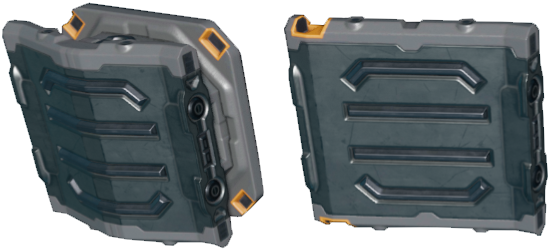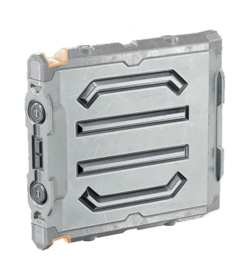Difference between revisions of "Radiator"
Jump to navigation
Jump to search
| (4 intermediate revisions by the same user not shown) | |||
| Line 98: | Line 98: | ||
== Device fields == | == Device fields == | ||
<section begin=deviceFields/> | |||
===Radiator Base=== | ===[[Radiator|Radiator Base]]=== | ||
{|class="wikitable" | {|class="wikitable" | ||
! YOLOL field | ! YOLOL field | ||
| Line 106: | Line 106: | ||
! Range | ! Range | ||
|- | |- | ||
! ''' | ! '''RadiatorHeatDissipation''' | ||
| Current radiation rate for this radiator base | |||
| 0 - 1500 | |||
| Current radiation rate for this | |||
| 0 - | |||
|- | |- | ||
! ''' | ! '''RadiatorStoredHeat''' | ||
| Current | | Current amount of heat in this radiator base | ||
| 0 - | | 0 - RadiatorMaxStoredHeat | ||
|- | |- | ||
! ''' | ! '''RadiatorMaxStoredHeat''' | ||
| Maximum amount of | | Maximum amount of heat that can be stored in the radiator base | ||
| | | 1500 | ||
|- | |- | ||
|} | |} | ||
===Radiator Extension=== | ===[[Radiator|Radiator Extension]]=== | ||
{|class="wikitable" | {|class="wikitable" | ||
! YOLOL field | ! YOLOL field | ||
| Line 130: | Line 126: | ||
! Range | ! Range | ||
|- | |- | ||
! ''' | ! '''RadiatorHeatDissipation''' | ||
| | | Current radiation rate for this radiator extension | ||
| 0 - | | 0 - 750 | ||
|- | |||
! '''RadiatorStoredHeat''' | |||
| Current amount of heat in this radiator extension | |||
| 0 - RadiatorMaxStoredHeat | |||
|- | |- | ||
! ''' | ! '''RadiatorMaxStoredHeat''' | ||
| | | Maximum amount of heat that can be stored in the radiator extension | ||
| | | 1500 | ||
|- | |- | ||
|}<section end=deviceFields/> | |}<section end=deviceFields/> | ||
Latest revision as of 00:00, 19 March 2023
Radiators are very effective options for sustained cooling, but often they require heatsinks to reach their full potential. Each section attached extends the radiator's maximum performance without requiring additional mounting slots. Radiators can be used in conjunction with cooling racks, but it is not required.
Types
Radiator base
Size 72×72×48 cm
Mass 1,404.8 kg
Volume 141.19 kv
Corrosion resistance 310
Primary material Bastium
Input / Output
Heat capacity 1,500
Heat dissipation 1,500 per second
Modular interfaces 2
Device interfaces 1
Composition
Basic usage
- Radiator Bases can be mounted on hardpoints and Radiator Extensions can be mounted to Radiator Bases or other Extensions.
- Radiator Bases have one device interface and two modular output interfaces (where you can connect Radiator Extensions' input interface).
- Radiator Extensions have one input (side with colored bolting spots) and one output interface.
- Both Bases and Extensions can also be mounted on generators, fuelchambers or heatsinks, but that might be unintended behaviour.
- Radiators remove heat transferred to them by heat producers and heatsinks.
- Heat is transferred through pipes or connected devices.
- Note: Devices have a limit to how much of their heat they can transfer to radiators (default 75, heatsinks 750 - can be added together). See heat mechanics for in depth info.
Device fields
Radiator Base
| YOLOL field | Description | Range |
|---|---|---|
| RadiatorHeatDissipation | Current radiation rate for this radiator base | 0 - 1500 |
| RadiatorStoredHeat | Current amount of heat in this radiator base | 0 - RadiatorMaxStoredHeat |
| RadiatorMaxStoredHeat | Maximum amount of heat that can be stored in the radiator base | 1500 |
Radiator Extension
| YOLOL field | Description | Range |
|---|---|---|
| RadiatorHeatDissipation | Current radiation rate for this radiator extension | 0 - 750 |
| RadiatorStoredHeat | Current amount of heat in this radiator extension | 0 - RadiatorMaxStoredHeat |
| RadiatorMaxStoredHeat | Maximum amount of heat that can be stored in the radiator extension | 1500 |
To learn more about how to use fields, consult these wiki pages:


